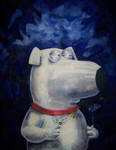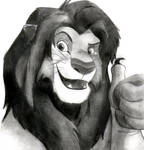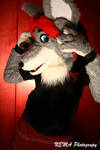Anthro Art - The Beginning
Anthropomorphism is the attribution of human characteristics and qualities to non-human beings, objects, natural, or supernatural phenomena. Gods, animals, the forces of nature, and unseen or unknown authors of chance are frequent subjects of anthropomorphosis. The term comes from two Greek words, άνθρωπος (anthrōpos), meaning "human," and μορφή (morphē), meaning "shape" or "form." The suffix "-ism" originates from the morpheme "-isma" in the Greek language. .[1]
The actual 'date' when Anthropomorphic art came to light isn't well documented so we can only go off what has been left behind for us to observe. This is most noted in literature, sculptures and fables.
Pre-History

From the beginnings of human behavioral modernity in the Upper Paleolithic, about 40,000 years ago, examples of zoomorphic (animal-shaped) works of art occur that may represent the earliest evidence we have of anthropomorphism [3] in art, culture and expression. One of the oldest known is an ivory sculpture, the Lion man of the Hohlenstein Stadel, Germany, a human-shaped figurine with a lion's head, determined to be about 32,000 years old.
As we progress through history anthropomorphism in art becomes more abundant as fables, tales and expression begin to envelope the human culture. We see images carved out from the great Egyptian Gods to the Celtic tales of old that depict walking rabbits, frogs and dogs.
We have a natural connection to animals and one could speculate as to why we would combine our attributes and characteristics to animals. This was highly projected into stories and fables for young children to appreciate.
Literature and Fables - Where It Begins

Stories have been passed on from generation to generation. They tell of great adventures, odd and lovely characters and usually projects some sort of meaning behind it.
Anthropomorphism, sometimes referred to as personification, is a well established literary device from ancient times. It extends back to before Aesop's Fables[4] in 6th century BC Greece and the collections of linked fables from India, the Jataka Tales and Panchatantra, which employ anthropomorphised animals to illustrate principles of life. Many of the stereotypes of animals that are recognised today, such as the wiley fox and the proud lion, can be found in these collections. Aesop's anthropomorphisms were so familiar by the 1st century AD that they coloured the thinking of at least one philosopher:
And there is another charm about him, namely, that he puts animals in a pleasing light and makes them interesting to mankind. For after being brought up from childhood with these stories, and after being as it were nursed by them from babyhood, we acquire certain opinions of the several animals and think of some of them as royal animals, of others as silly, of others as witty, and others as innocent.- Apollonius of Tyana [3]
Anthropomorphic motifs have been common in fairy tales from the earliest ancient examples set in a mythological context to the great collections of the Brothers Grimm and Perrault. The Tale of Two Brothers (Egypt, 13th century BC) features several talking cows and in Cupid and Psyche (Rome, 2nd century AD) Zephyrus, the west wind, carries Psyche away. Later an ant feels sorry for her and helps her in her quest.
Modern Literature With the popularity of fables in our early past it paved the way for some great inspiration on future publications such as Alice's Adventures in Wonderland (1865) by Lewis Carroll, The Adventures of Pinocchio (1883) by Carlo Collodi and The Jungle Book (1894) by Rudyard Kipling, all employing anthropomorphic elements. This continued in the 20th century with many of the most popular titles having anthropomorphic charactersAlice's Adventures in Wonderland (1865) by Lewis Carroll, The Adventures of Pinocchio (1883) by Carlo Collodi and The Jungle Book (1894) by Rudyard Kipling, all employing anthropomorphic elements. This continued in the 20th century with many of the most popular titles having anthropomorphic characters.
[3]
With this, the fantasy genre expanded to new heights and stories. The best-selling examples of the genre are The Hobbit[19] (1937) and The Lord of the Rings (1954–1955), both by J. R. R. Tolkien, books peopled with talking creatures such as ravens, spiders and the dragon Smaug and a multitude of anthropomorphic goblins and elves.The best-selling examples of the genre are The Hobbit[19] (1937) and The Lord of the Rings[20] (1954–1955), both by J. R. R. Tolkien, books peopled with talking creatures such as ravens, spiders and the dragon Smaug and a multitude of anthropomorphic goblins and elves.
[3
Tolkien saw this anthropomorphism as closely linked to the emergence of human language and myth
"...The first men to talk of 'trees and stars' saw things very differently. To them, the world was alive with mythological beings... To them the whole of creation was "myth-woven and elf-patterned 3]
Film Television

1920's - Present The most noted examples of Anthropomoprhic characters in Film and Television is Walt Disney characters. This includes Mickey Mouse, Donald Duck, The Brave Little Toaster, Oswald the Lucky Rabbit, and Bugs Bunny and more.
The Family guy, Brian, shows many human characteristics, such as the ability to walk upright and talk. However he also acts like a normal dog in other ways, for example he cannot resist chasing a ball.[3]



1960's - 1996Since the 1960s, anthropomorphism has also been represented in various animated TV shows such as Biker Mice From Mars (1993-1996) and SWAT Kats: The Radical Squadron (1993-1995). Teenage Mutant Ninja Turtles, first aired in 1987, features four pizza-loving anthropomorphic turtles with a great knowledge of ninjutsu, led by their anthropomorphic rat sensei, Master Splinter. [3]

 :thumb121465691:
:thumb121465691:Anthropomorphism Outside of "Art"
The "Fur Fandom" "A Furry" is a term invented by a group of people who have many levels of interest in the personification of animals. If the anthropomorhised thing happens to be an animal that has fur....people of this state of mind assume it is "a furry." People who say they are "a furry" associate with what is called the furry fandom. The "Furry Fandom" is used to describe a social group of people with certain characteristics and traits involving Anthro art and expressing it through visual means. For example, artists or enthusiasts dress up like their beloved characters. It isn't strictly limited to characters, however, as others just like to express themselves and their love for animals by adorning themselves in related clothes or props. Everyone expresses their passions differently!
 :thumb285003690:
:thumb285003690:Projecting Human Nature Onto Nature Anthropomorphism extends beyond the medium of art and seeps into the natural world in which we live in. This is where we, as humans, take the context of art and our expression of it and apply it to real things in the world such as animals.
Humans are a compassionate, emotional and intelligent being. We tend to project our emotions onto animals and the study and observations of them.
The study of great apes in their own environment has changed attitudes to anthropomorphism, as an example.[2] In the 1960s the three so-called "Leakey's Angels", Jane Goodall studying chimpanzees, Dian Fossey studying gorillas and Biruté Galdikas studying orangutangs, were all accused of "that worst of ethological sins" anthropomorphism"..[2] The change was brought about by their descriptions of the great apes in the field; it is now more widely accepted that empathy has an important part to play in research. As Frans de Waal writes:
"To endow animals with human emotions has long been a scientific taboo. But if we do not, we risk missing something fundamental, about both animals and us.".[2]
References
1. NewWorldEncyclopedia.org
2.Psychological Review 53 (2) : 88–106. doi:10.1037/h0063033. PMID 21023321- 3.Wikipedia - Anthro Art
- 4.The Hawk and the Nightingale, recorded by Hesiod in his Works and Days is regarded by some as the earliest fable attributable to a literary work. See for instance Britanica. 1910. pp. 410.: "The poem also contains the earliest known fable in Greek literature"
- 4. Literature & Fable header image. Alice In Wonderlands Rabbit, Egyptian Gods, Aesop's Fables "Two Mice"


